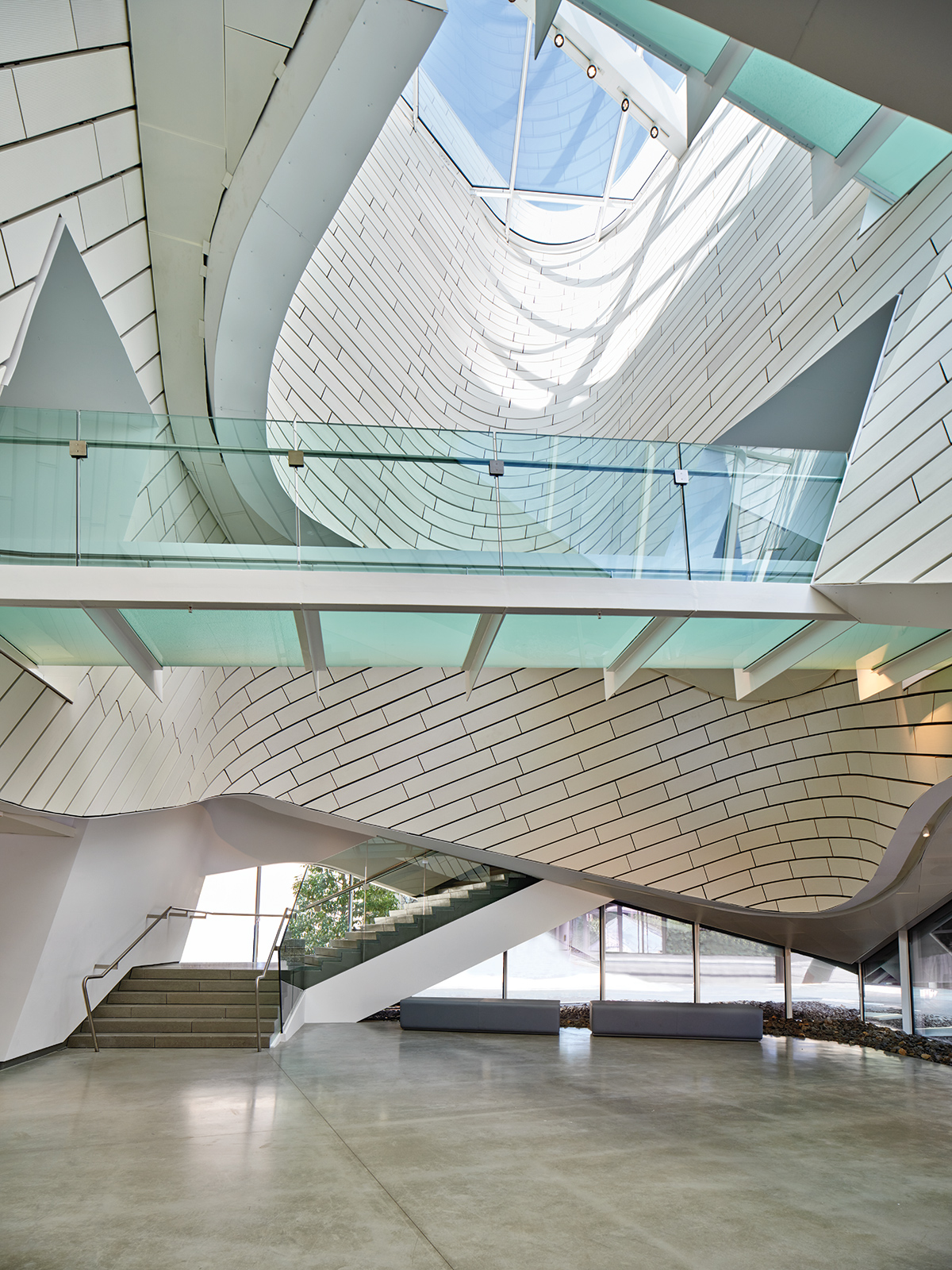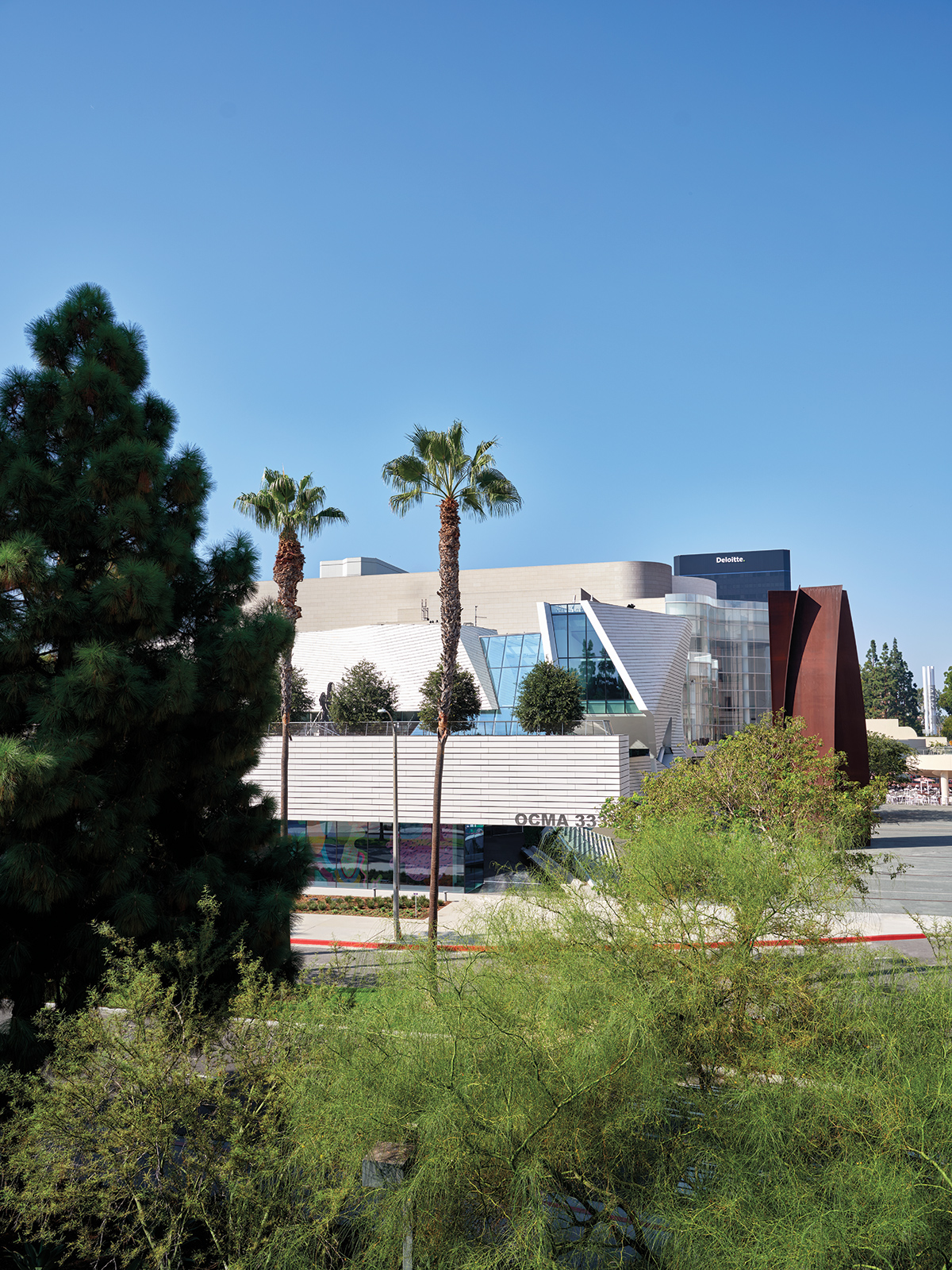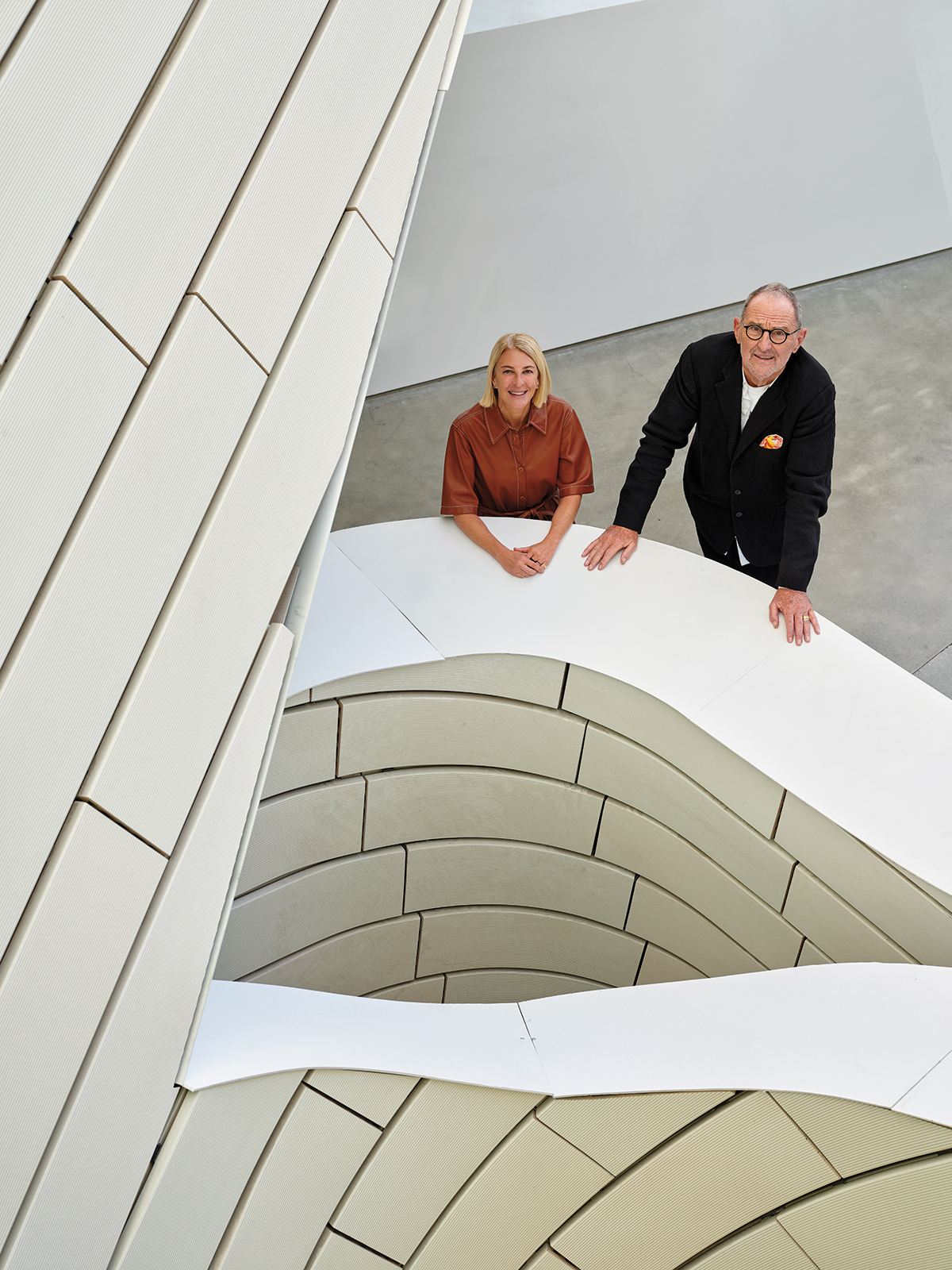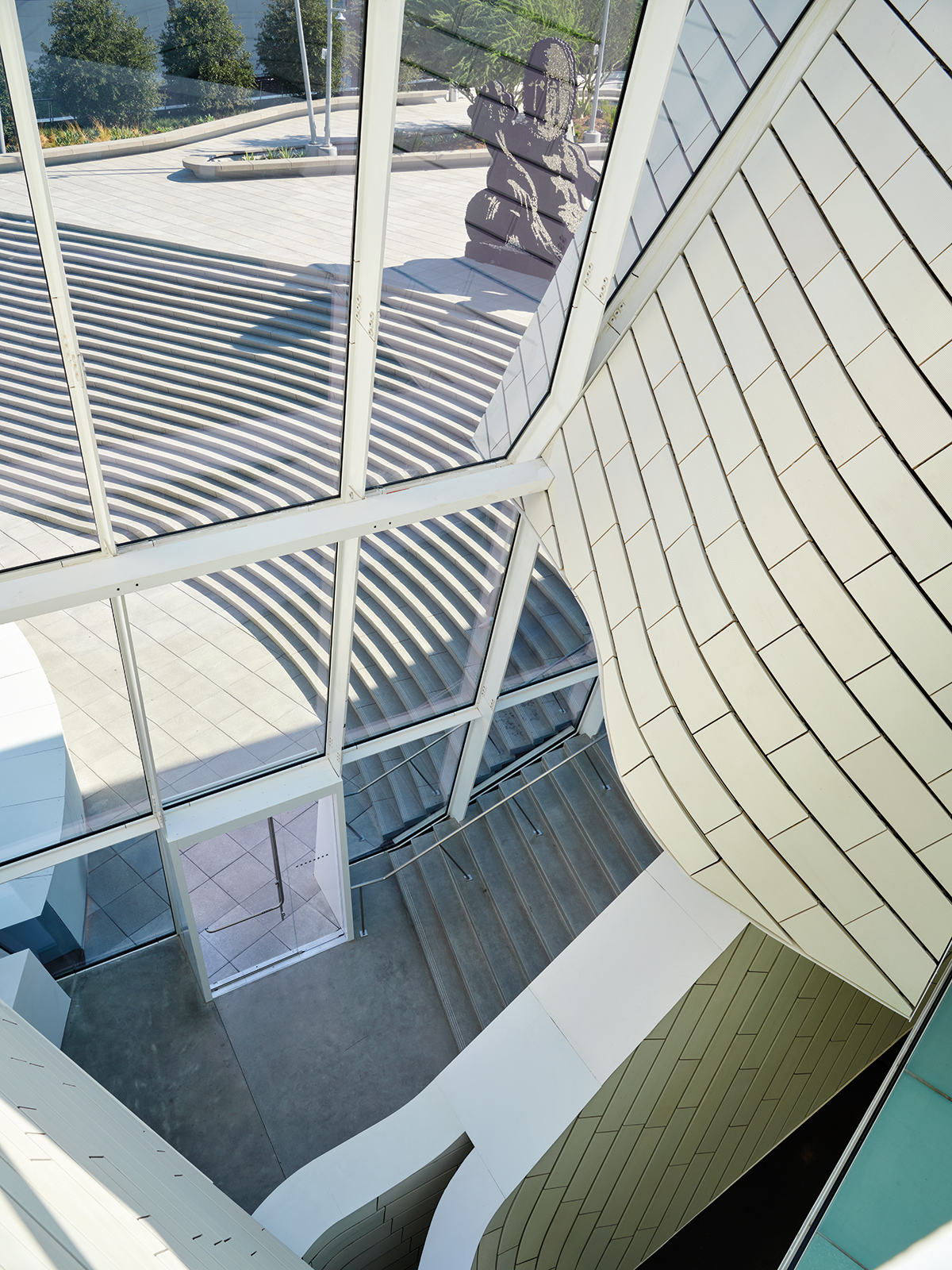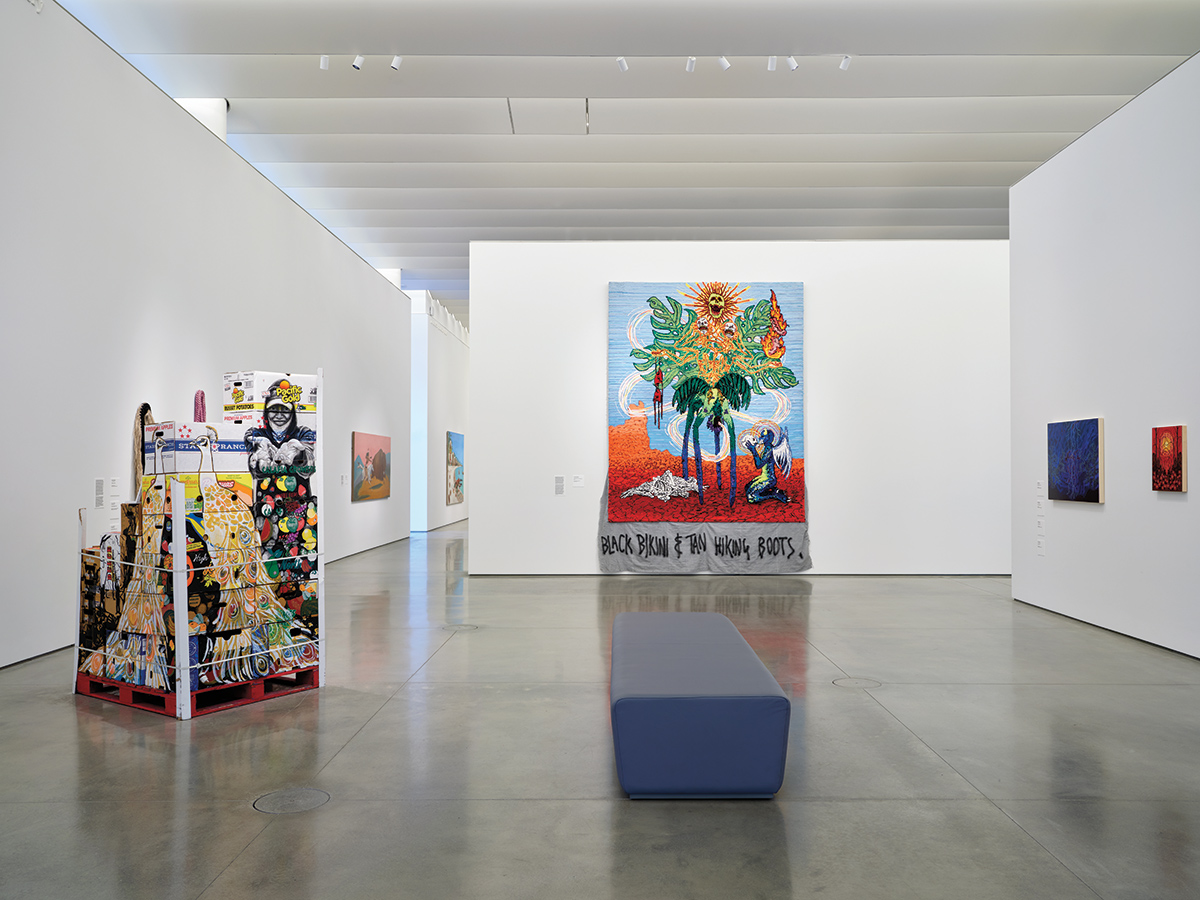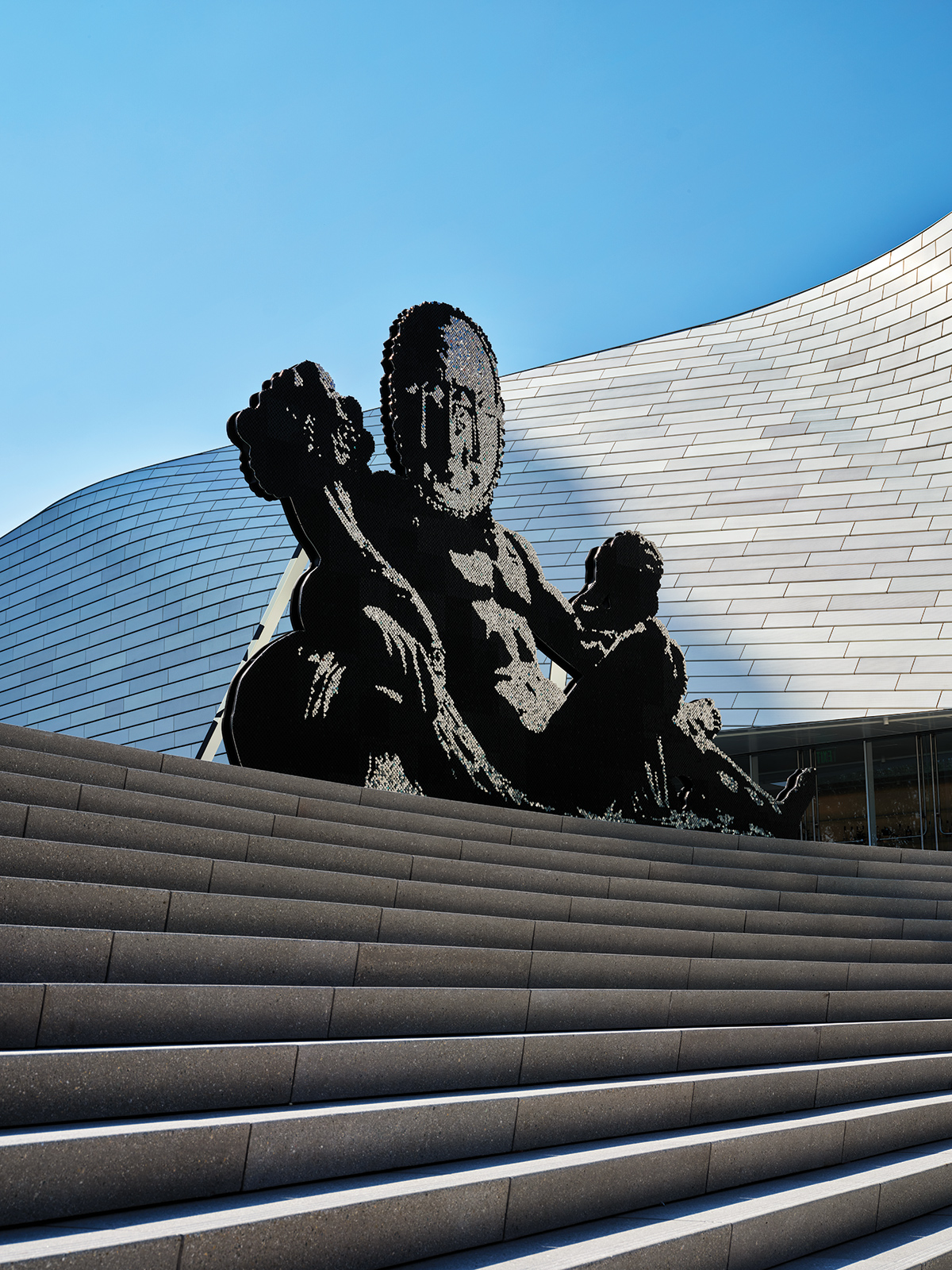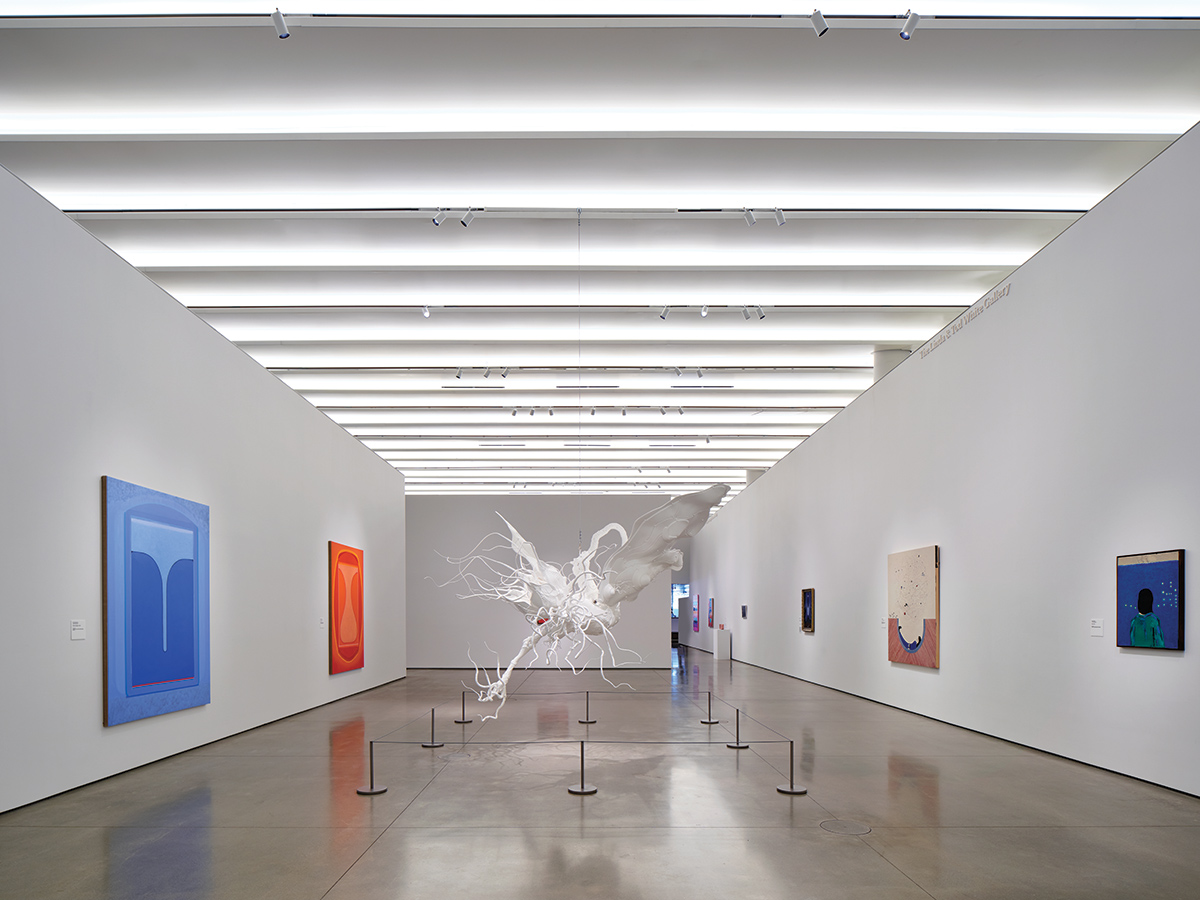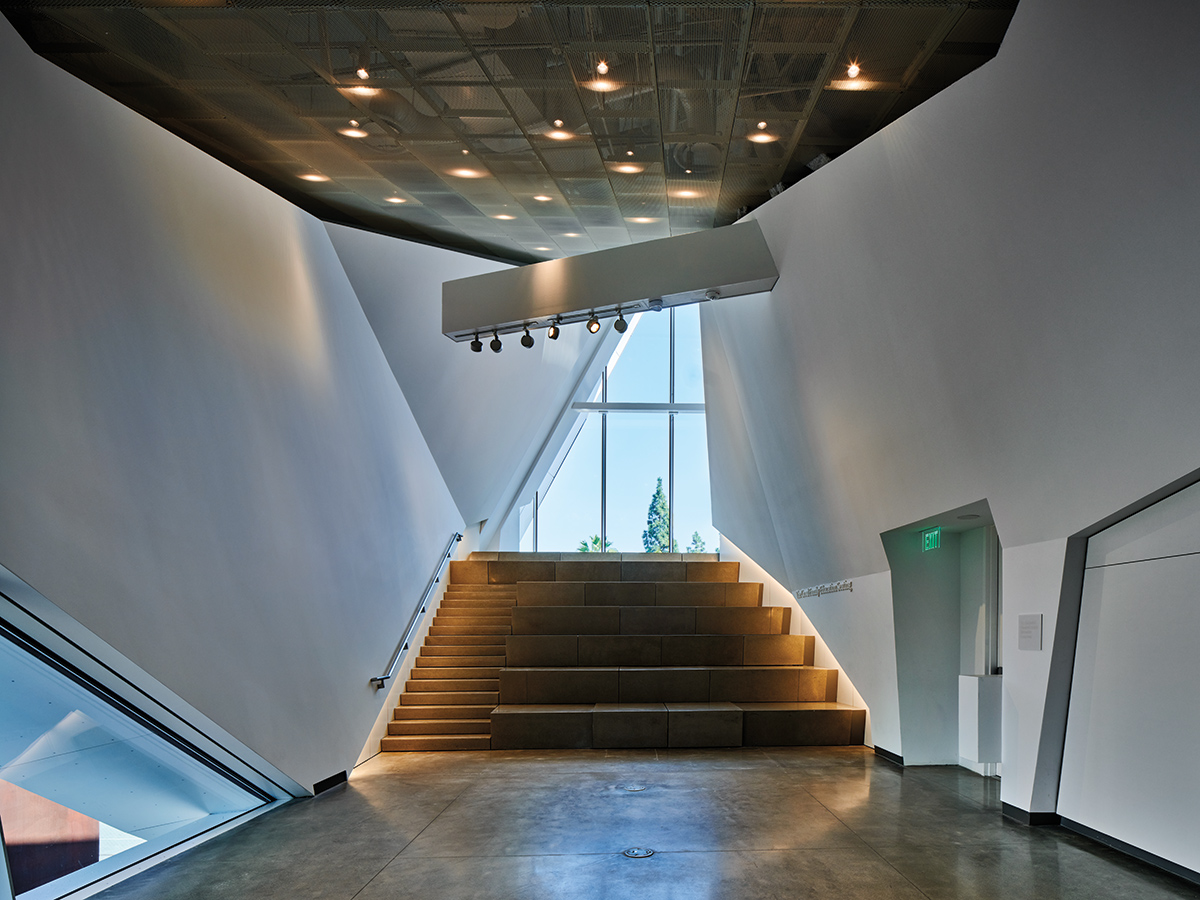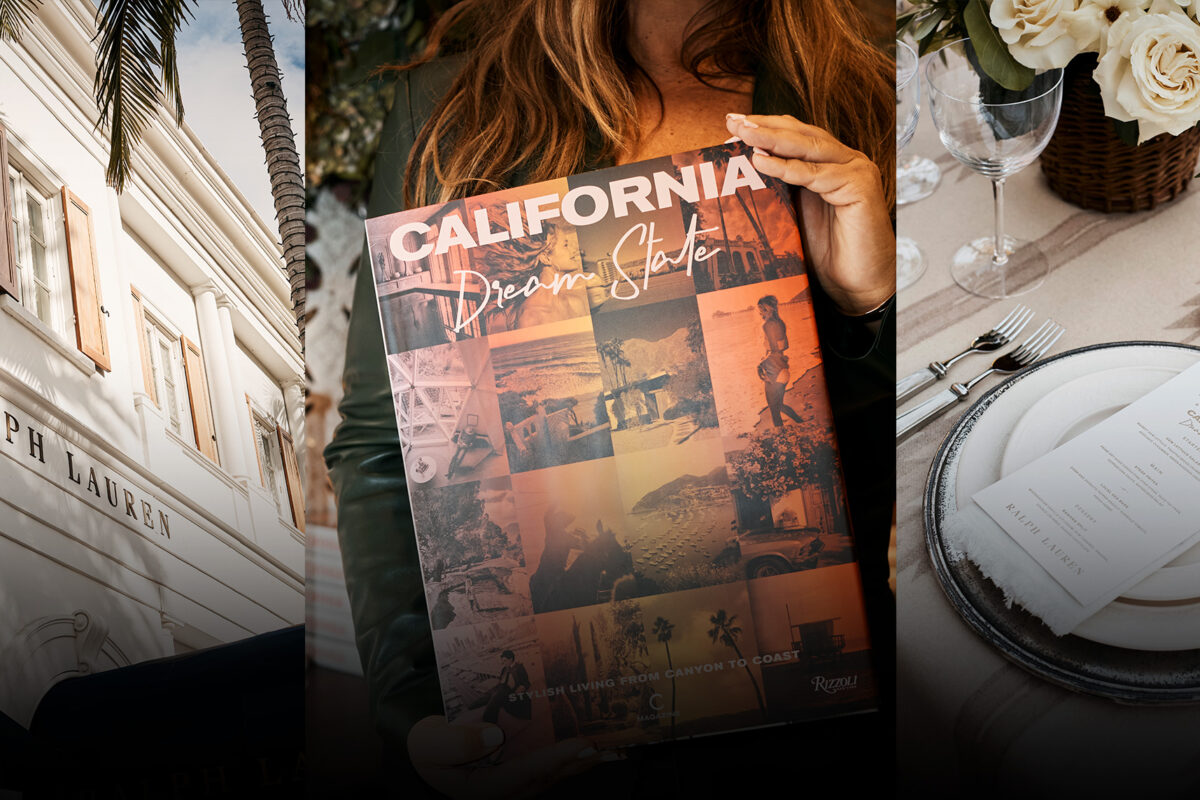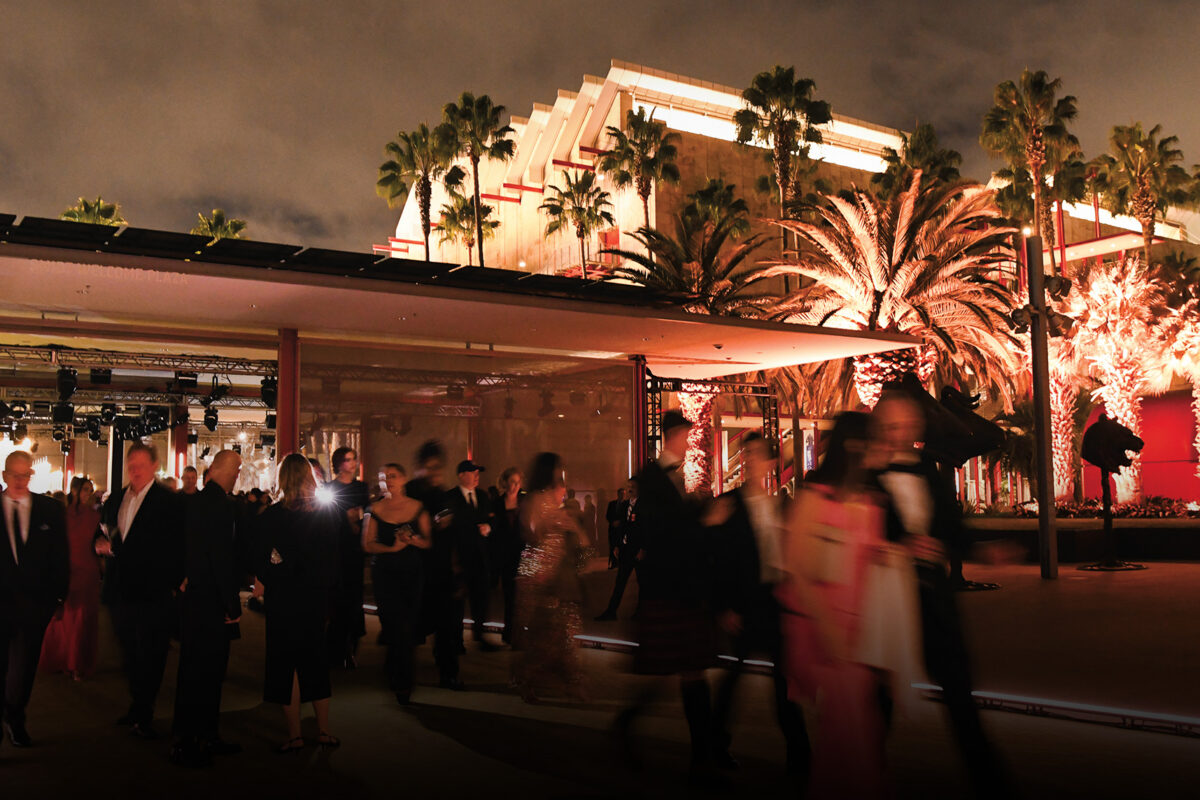Fourteen years and 17 designs later, the expanded Orange County Museum of Art is finally open. Architect Thom Mayne of Morphosis and director Heidi Zuckerman tell why California’s new-look art institution is a world-beater
Photography by ROGER DAVIES
Words by STEPHANIE RAFANELLI
In 2006, Richard Serra installed his site-specific, 65-foot-tall weatherproofed steel sculpture beside an empty 1.64 acre site—the only free lot left at the Segerstrom Center for the Arts in Costa Mesa, next to the Renée & Henry Segerstrom Concert Hall. It was prophetically entitled Connector, and only now can its meaning be fully understood.
The 10,000-square-foot upper plaza space is reached by a grand, sky-lit public staircase.
In October, the new Orange County Museum of Art building—14 years, 17 designs and $94 million in the making—finally opened on that adjacent lot donated by the Segerstrom family, the arts-supporting owners of South Coast Plaza. Designed by Pritzker Prize-winning architect Thom Mayne of Culver City’s Morphosis, the dynamic community-focused urban space promises to be a new connective center of suburban Orange County and a prototype for 21st-century museums.
It also completes the plumb line of star architect-designed Californian art institutions: From the newly renovated Museum of Contemporary Art San Diego by Selldorf Architects to LACMA’s ongoing redesign by Pritzker Prize winner Peter Zumthor (set to be completed in 2024) to Snøhetta’s expansion of the San Francisco Museum of Modern Art in 2016. “We fill in a geographic gap for contemporary art and culture in California,” says Heidi Zuckerman, OCMA’s dynamo CEO and director, who since January 2021 has turbocharged the last phase of construction, after ground was broken nearly two years earlier. Like the final beam in an architectural topping-out ceremony, the groundbreaking upgrade of the historic Southern California institution is the final brick in California’s status as a world-class art destination, the culmination of a series of developments given critical mass by the launch of the international art fair Frieze Los Angeles in 2019. But the last piece is never easy to find—or build.
Untitled, 1989, by Barbara Kruger.
The story of OCMA’s expansion is an episodic affair that runs parallel to the history of Orange County. Born as the Balboa Pavilion Gallery in the eponymous Newport Beach building (now a historic landmark) in 1962, the museum was founded by a group of 13 radical women who wanted to give a home to a new breed of postwar West Coast artists, many graduating from SoCal’s art schools. In 1968, it jointly showed pop artists Joe Goode and Ed Ruscha, graduates of Chouinard Art Institute (now absorbed into the California Institute of the Arts), where they studied under Robert Irwin of the Light and Space Movement. In 1977, the ever-expanding gallery, renamed the Newport Harbor Art Museum, moved to a new space on San Clemente Drive near Fashion Island—a shopping center developed by The Irvine Company and opened in 1967, the same year that the Segerstrom family debuted South Coast Plaza, a premier mall built on a portion of their farmland.
OCMA’s perch on Avenue of the Arts in Costa Mesa.
The appointment of 27-year-old Paul Schimmel—future chief curator of MOCA—in 1981 significantly raised the bar, expanding the permanent collection with contemporary West Coast artists like Robert Irwin, L.A. painter John Altoon, John Baldessari, Vija Celmins and James Turrell, as well as the introduction of what was then called the Newport Biennial (now known as the California Biennial) for newly emerging artists. After a problematic short-lived merger with the Laguna Art Museum, the gallery was renamed the Orange County Museum of Art in 1997, and later helmed by director Dennis Szakacs and curator Elizabeth Armstrong. “Liz Armstrong explained to me that OCMA has been like a perpetual start-up,” says Zuckerman, who grew up in Palo Alto and later held a senior curatorial position at Berkeley Art Museum and Pacific Film Archive. “When the museum was founded 60 years ago, Orange County itself was nascent.” By the time the Segerstrom family had deeded the land to the museum in 2008 and Morphosis won the competition to build a new OCMA, effectively doubling its exhibition space, the population of Orange Country was reaching 3 million and South Coast Plaza was (and still is) the biggest mall on the West Coast, with Chanel, Gucci and Prada among its luxury stores.
Orange County Museum of Art CEO and Director Heidi Zuckerman with architect Thom Mayne of Morphosis.
But the ambitious project was blighted by a decade of delays, changes in leadership and therefore direction. Not too long after David Cameron became chief curator, Szakacs resigned from his post as director and CEO in 2013 and was later replaced by Todd Smith, who then departed in 2020, after which Zuckerman was courted as the person to finish the job. (She had previously transformed the Aspen Art Museum into a world-class institution and, as director, oversaw the ground-up construction of its new building, designed by another Pritzker Prize holder, Shigeru Ban.) It wasn’t until 2018, four years after the Aspen Art Museum was completed, that Mayne’s highly anticipated plans for the OCMA building were finally unveiled and the Newport Beach site closed its doors. In the interim, the museum opened its temporary location, dubbed OCMAExpand—Santa Ana, in South Coast Plaza Village. By that time, Morphosis, founded by Mayne in 1972 at the intersection of urbanism and architecture, had evolved as a practice, and Mayne’s vision for the museum had shifted.
The piazza and light-filled atrium when viewed from the mezzanine bridge.
“Those 14 years produced something that we couldn’t have produced otherwise, an opportunity to understand the nature of the work,” says the 78-year-old maverick architect. “[That had] very specific idiosyncratic notions of a museum, that was specific to this time, place, community and culture, specifically Orange County, which is a very young, dispersed place that doesn’t have a traditional center.” All this was placed within the set architectural context of the Segerstrom Center for the Arts campus, which includes the Renée and Henry Segerstrom Concert Hall by Argentine architect César Pell, the Argyros Plaza (redesigned by Michael Maltzan), and of course, Serra’s sculpture. “We were with Serra [on this idea that] it had to be about relationships and connectivity. Not another architectural object of desire, designed by particular chosen architects about Architecture with a capital A. [I have the] highest regard for buildings that seem inevitable, like they belong.” The game changers for the evolving design were Morphosis’ completion of New York’s 41 Cooper Square (2009) and the Perot Museum of Nature and Science in Dallas (2012)—both built as broad, public urban spaces with central atriums.
“We fill in a geographic gap for contemporary art and culture in California”
Heidi Zuckerman
Thom Mayne and Heidi Zuckerman.
“In some ways, we developed the OCMA project as a piazza, not even a building, with an energetic piece that activated [the gallery],” says Mayne. The 53,000-square-foot space features an undulating terracotta facade and light-filled atrium, above which hovers a dynamic sculptural education center designed to entice and inspire, not backroom, young art fans. The 10,000-square-foot upper plaza space is reached by a grand public staircase, “which is purposefully symbolic. It belongs to the Met, the New York Public Library; it’s urban.” Meanwhile, all traditional physical barriers to entry were removed to make the museum more accessible, some art visible from street level without the need to enter the building.
The interior houses a 4,500-strong permanent collection including works by Catherine Opie, Sterling Ruby and John Baldessari.
Of Many Waters by Sanford Biggers.
The interior features 25,000 square feet of grand, connective gallery spaces with plenty of airflow, retractable walls and a mezzanine to accommodate world-class traveling shows and the more than 4,500 works of art in the permanent collection: A diverse range of sculptures, paintings and installations from Andy Warhol’s Mao to Chris Burden’s giant sand-laden sculpture A Tale of Two Cities to anarchist installation artist Richard Jackson’s neon sign Ain’t Painting a Pain. The space is ready for whatever the 21st century may bring. “The notion was to be open to any future possibility, including scale. We gave them basically a large room and access to that room, a total neutrality of space. And we gave them a piazza for exterior exhibits. I was thinking of Anish Kapoor’s enormous inflatables shown at the Grand Palais [in Paris in 2011]. You want to be able to open to characters like Kapoor,” says Mayne.
All this coming together “was both an artisanal and a high-tech process,” says Brandon Welling, Morphosis’ partner-in-charge, of the project. “We built the building first in a computer; everything from a panel to a bolt is modeled in advance to see if it fits. We 3D printed all the tiles in advance, and we shipped the forms to New York.” The group also adhered to high environmental standards, many of which had been set by the Smithsonian to comply with guidelines such as temperature controls for rare works of art. “From the outset, this museum wanted to bring in the highest-level shows. The way to control temperature architecturally is to create hermetically sealed chambers, but we wanted to have these large open connective spaces and so it was a challenge in hot, humid Southern California, requiring very robust mechanical systems.”
The “13 Women” exhibition includes Lee Bul’s Supernova, 2000 (center).
Surfing on Acid by Mary Heilmann from the inaugural “13 Women” exhibition.
Welling credits Anton Segerstrom, art collector and South Coast Plaza heir, for pushing the project forward all these years. But it was Zuckerman who supercharged it to its conclusion, raising the last $40 million needed, and reconfigured the museum’s post-pandemic role as a public sanctuary “by acknowledging that we live in a time of high anxiety and knowing that art can be a salve,” she says. As the museum’s newly appointed director, she also made design tweaks, such as removing every switch and sensor off the walls and moving it to the floors and ceilings, “so that the walls could be a sacred space for the presentation of art.” In addition, thanks to a generous sponsorship deal she brokered with Newport Beach-based Lugano Diamonds, there will be free entry for the next 10 years, fulfilling OCMA’s credo of being “a 21st-century museum that welcomes everyone by removing barriers to entry.”
OCMA features 25,000 square feet of connective gallery spaces with retractable walls and a mezzanine to accommodate traveling shows.
“Looking back to look forward,” her overarching vision for OCMA means both reclaiming its disjointed narrative and filling in collection gaps, whether historical or in terms of diversity. She overdelivered on her acquisitions initiative, 60 for 60 (in time for the museum’s 60th anniversary), by bringing in 80 new works, including two pieces from Catherine Opie’s Surfer Series, “that could be the [iconic] images of Orange County.” These will feature in the Zuckerman-curated opening show “13 Women,” a tribute to the gallery’s founders, alongside works by Joan Brown of the Bay Area Figurative Movement and Barbara Kruger. Meanwhile, the California Biennial returns after a five-year hiatus under a curatorial team led by Liz Armstrong alongside Essence Harden, visual arts curator of the California African American Museum, and Gilbert Vicario, the Phoenix Art Museum’s chief curator. Zuckerman tips San Francisco-based Clare Rojas (“I love the notion of a contemporary hieroglyphic”) as one to watch alongside abstract “spiritual” painter Lily Stockman, who works between L.A.’s Frogtown and the Mojave Desert. “I think there’s something about abstraction that taps into a place into your brain that opens up portals for consciousness.”
Also opening is an exhibition on Venice Beach-based Fred Eversley, the only black artist in the Light and Space Movement, a former rocket scientist and NASA engineer known for his reflective resin “lens” sculptures, whose first solo show took place at OCMA in 1978. Meanwhile, a large, outdoor, site-specific horizontal figurative sculpture with steel sequins by L.A.-born artist Sanford Biggers has been installed as an answer to Serra’s Connector. Zuckerman concludes: “We’ve [finally] built the museum that Orange County deserves.”

Feature image: Sitting adjacent to South Coast Plaza, the 53,000-square-foot site was designed by Morphosis to include a piazza for exterior exhibits—including Sanford Biggers’ Of Many Waters sculpture (pictured)—and an undulating glass-and-terracotta-tiled facade so that some art is visible from street level.
This story originally appeared in the Winter 2022 issue of C Magazine.
Discover more CULTURE news.
See the story in our digital edition


